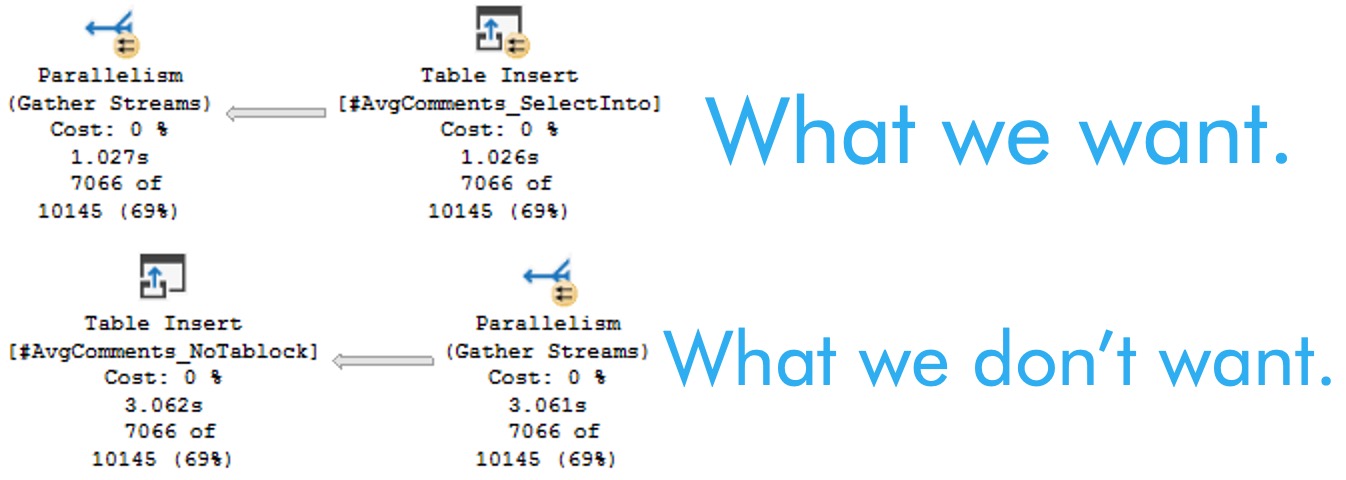Do That, But Faster
Serial zones in parallel plans can leave a lot of performance on the table. One of the best ways to see that is with insert queries that do a lot of work. A big contrast between @table variables and #temp tables is that the former fully disallows parallelism in modification queries, and the latter do not.
The story gets a little more complicated when inserting into a columnstore index, but this post isn’t really about that.
Let’s look at some scenarios where a fully parallel insert is allowed, and then not allowed.
The thing to keep an eye out for is the insert operator being in the serial zone. For the purposes of this thread:

Works: SELECT INTO
As long as you don’t do anything too goofy here, a fully parallel insert will “always” be allowed, here.
Goofy things will be explained later in the post.
--This will "always" work, as long as you don't do
--anything listed below in the "broken" select
SELECT
C.UserId,
SumScore =
SUM(C.Score)
INTO
#AvgComments_SelectInto
FROM
dbo.Comments AS C
GROUP BY
C.UserId
HAVING
SUM(C.Score) > 200;
DROP TABLE #AvgComments_SelectInto;
Works: INSERT, with TABLOCK
Rather than selecting directly into a table, here we’re gonna create the table and issue an insert statement with the tablock hint.
--This *will* get you a fully parallel insert, unless goofiness is involved.
CREATE TABLE
#AvgComments_Tablock
(
UserId int,
SumScore int
);
INSERT
#AvgComments_Tablock WITH (TABLOCK)
(
UserId,
SumScore
)
SELECT
C.UserId,
AvgScore =
SUM(C.Score)
FROM
dbo.Comments AS C
GROUP BY
C.UserId
HAVING
SUM(C.Score) > 200
DROP TABLE #AvgComments_Tablock
Doesn’t Work: INSERT, without TABLOCK
Without the tablock hint, this will get you the plan we don’t want, where the insert operator is outside the parallel zone.
--This will not get you a fully parallel insert
CREATE TABLE
#AvgComments_NoTablock
(
UserId int,
SumScore int
);
INSERT
#AvgComments_NoTablock
(
UserId,
SumScore
)
SELECT
C.UserId,
SumScore =
SUM(C.Score)
FROM
dbo.Comments AS C
GROUP BY
C.UserId
HAVING
SUM(C.Score) > 200;
DROP TABLE #AvgComments_NoTablock;
Doesn’t Work: A Whole Laundry List Of Stuff
Basically any one thing quoted out has the ability to deny the parallel insert that we’re after.
If you’re doing any of this stuff, like, bye.
--SET ROWCOUNT Any_Number;
--ALTER DATABASE StackOverflow2013
-- SET COMPATIBILITY_LEVEL = Anything_Less_Than_130;
CREATE TABLE
#AvgComments_BrokenTablock
(
--Id int IDENTITY,
UserId int,
SumScore int,
--INDEX c CLUSTERED(UserId)
--INDEX n NONCLUSTERED(UserId)
);
--Also, if there's a trigger or indexed view on the target table
--But that's not gonna be the case with #temp tables
INSERT
#AvgComments_BrokenTablock WITH (TABLOCK)
(
UserId,
SumScore
)
--The rules here are a little weird, so
--be prepared to see weird things if you use OUTPUT
--OUTPUT Inserted.*
--To the client or
--INTO dbo.some_table
--INTO @table_varible
SELECT
--Id = IDENTITY(bigint, 1, 1),
--dbo.A_Scalar_UDF_Not_Inlined_By_Froid
C.UserId,
SumScore =
SUM(C.Score)
FROM
dbo.Comments AS C
--Any reference to the table you're inserting into
--Not exists is just an easy example of that
--WHERE NOT EXISTS
--(
-- SELECT
-- 1/0
-- FROM #AvgComments_BrokenTablock AS A
-- WHERE A.UserId = C.UserId
--)
GROUP BY
C.UserId
HAVING
SUM(C.Score) > 200;
DROP TABLE #AvgComments_BrokenTablock;
Explainer
There are many good reasons to want a fully parallel insert, but you need to make sure that the bottleneck isn’t earlier in the plan.
If it is, you may not see the full performance gains from getting it.
In general, it’s a good strategy when building larger #temp tables, but at this point I add a tablock hint to every #temp table insert at first to test things out.
Thanks for reading!
Going Further
If this is the kind of SQL Server stuff you love learning about, you’ll love my training. I’m offering a 75% discount to my blog readers if you click from here. I’m also available for consulting if you just don’t have time for that and need to solve performance problems quickly.
Related Posts
- What’s Really Different About In-Memory Table Variables In SQL Server?
- Common Table Expressions Are Useful For Rewriting Scalar Functions In SQL Server
- Multiple Distinct Aggregates: Still Harm Performance Without Batch Mode In SQL Server
- When Index Sort Direction Matters For Query Performance In SQL Server
Maybe (probably) I’m missing something, but why can’t the engine take care of this automatically? That is, it knows that it’s a temp table and so can only be accessed via the current session. From that standpoint, locking the table shouldn’t have any effect on concurrency.
I can think of a lot of reasons why you wouldn’t want to change the default behavior here, but you’d probably just think I’m crazy.
Curious minds want to know!
Too late – shoot your shot.
^
Parallel
Deadlocks